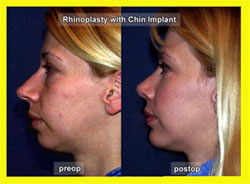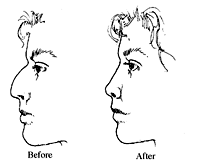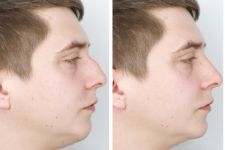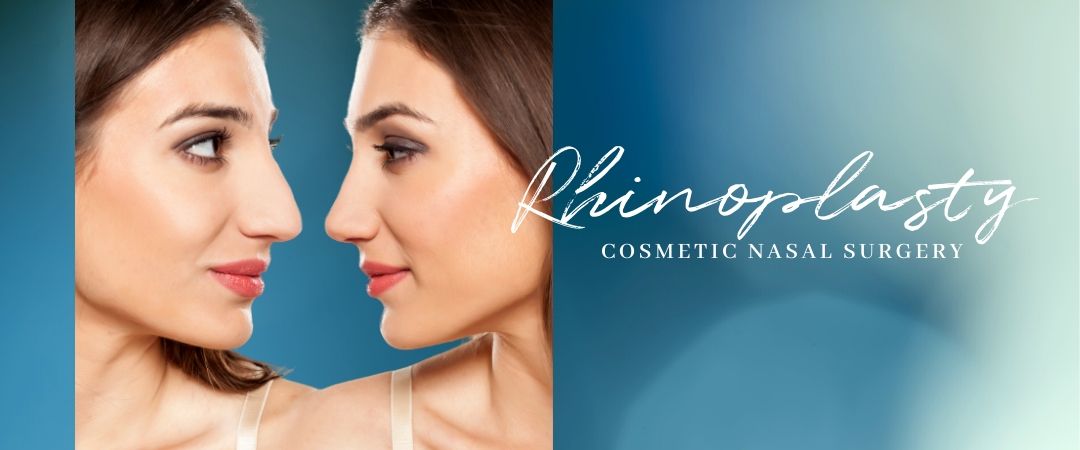Rhinoplasty, or cosmetic nasal surgery, is one of the more common cosmetic procedures performed today. The operation is usually carried out because a patient desires to improve his or her appearance. It is also frequently requested for repair of injuries or correction of the increasing disfigurement of the nose that occurs, as the patient grows older. In addition to the purely aesthetic reasons for seeking rhinoplasty, patients may also be influenced in their desire for surgery because of related functional problems such as breathing obstruction, which can also be addressed during the operation.
 Because of the frequency with which this operation is carried out, technical refinements have allowed consistently good results which are considerably better than were possible twenty-five or fifty years ago. Nevertheless, patients must recognize that the goal of this operation is improvement, and that perfection is a goal that remains elusive. Patients who expect too much may be disappointed. During your consultation, we may review other before and after pictures. The purpose of seeing other patients is not to allow you to pick out the nose that you want, but rather to give you some idea of the types of results that are generally achieved in this type of surgery.
Because of the frequency with which this operation is carried out, technical refinements have allowed consistently good results which are considerably better than were possible twenty-five or fifty years ago. Nevertheless, patients must recognize that the goal of this operation is improvement, and that perfection is a goal that remains elusive. Patients who expect too much may be disappointed. During your consultation, we may review other before and after pictures. The purpose of seeing other patients is not to allow you to pick out the nose that you want, but rather to give you some idea of the types of results that are generally achieved in this type of surgery.
PATIENT SELECTION – AGE AND SEX
The timing of the nasal reconstruction will depend on many factors. In general, cosmetic rhinoplasty should be delayed until a patient’s facial development is approaching maturity. This is usually around the age of fourteen for girls and fifteen for boys.
When surgery is carried out to correct breathing problems or to correct deformity produced by injury, it may be advisable to proceed with the operation at an earlier age. There is no upper age limit for nasal reconstruction. Patients in their sixties and seventies choose to have this operation with good results. Many patients combine nasal reconstruction with other types of surgery for aging such as facelift or corrective eyelid surgery.
ABOUT THE OPERATION
 The operation is carried out on an outpatient basis, under light general anesthesia. Most of the incisions are inside the nose and so visible scarring is limited. Dissection is assisted with the laser for increased precision and avoidance of bleeding. The laser has proven particularly valuable for sculpting of the nasal cartilage. Each operation is different, but basically the procedure involves shifting or removal of bone and cartilage and is therefore primarily a modification of the framework of the nose. Following surgery the skin redrapes itself over the new nasal framework and it is almost never necessary to remove excess skin. As mentioned, nearly all of the incisions are made within the nose. An exception is a small incision made at the base of the nose just above the lip. This incision heals well and is rarely visible. Incisions are closed with absorbable suture avoiding the need for removal. Often patients will combine chin or cheekbone augmentation (discussed elsewhere) with rhinoplasty for further profile enhancement.
The operation is carried out on an outpatient basis, under light general anesthesia. Most of the incisions are inside the nose and so visible scarring is limited. Dissection is assisted with the laser for increased precision and avoidance of bleeding. The laser has proven particularly valuable for sculpting of the nasal cartilage. Each operation is different, but basically the procedure involves shifting or removal of bone and cartilage and is therefore primarily a modification of the framework of the nose. Following surgery the skin redrapes itself over the new nasal framework and it is almost never necessary to remove excess skin. As mentioned, nearly all of the incisions are made within the nose. An exception is a small incision made at the base of the nose just above the lip. This incision heals well and is rarely visible. Incisions are closed with absorbable suture avoiding the need for removal. Often patients will combine chin or cheekbone augmentation (discussed elsewhere) with rhinoplasty for further profile enhancement.
NON FRACTURE RHINOPLASTY
Rhinoplasty is commonly thought of as a painful operation requiring fracture of the nasal bones and associated with considerable swelling and bruising. This is generally a misconception. It is important to realize that each operation is individualized according to the wants and needs of the patient. In many cases, the surgery requires only changes of cartilage, in which case, recovery is quicker and bruising, swelling and discomfort are much less likely.
While often the operation will require removal of bone or cartilage, there are often occasions where the nose needs augmentation, or filling in. If this is the case, synthetic fillers or the patient’s own cartilage may be used. This will be discussed on an individual basis.
POSTOPERATIVE CARE
 After completion of the operation, a small plastic splint is placed over the nose, which remains in place for about a week. Many patients express concern about having packs or gauze in the nose after surgery. Our technique avoids this need. It is no longer necessary to place packing inside the nose! After removal of the splint, there may be some swelling and bruising and stuffiness, but by the end of three weeks most patients find that a large part of the swelling has resolved.
After completion of the operation, a small plastic splint is placed over the nose, which remains in place for about a week. Many patients express concern about having packs or gauze in the nose after surgery. Our technique avoids this need. It is no longer necessary to place packing inside the nose! After removal of the splint, there may be some swelling and bruising and stuffiness, but by the end of three weeks most patients find that a large part of the swelling has resolved.
Patients must understand that although the major portion of the swelling resolves quickly, some will last for several months after the operation. In general, the appearance of the nose continues to improve for as long as a year after the operation. Do not be overly concerned if the nose looks unsatisfactory when the splint is first removed. Swelling is quite variable, and while it usually begins to subside quickly, some patients take much longer than others do.
Patients can wash or bathe normally after surgery. The splint can get wet. The nostrils are gently cleaned several times a day with cotton tip applicators wet with peroxide, after which a light coating of an antibiotic ointment should be applied. After removal of the splint, the patient must be very careful that the nose is not injured until complete healing has taken place. After full healing, the nose should be about as strong as ever, although one recent study has indicated that if the bones are fractured, the healed bone may be slightly more vulnerable to later injury.
The first three weeks after surgery are generally the most important. Although many patients can return to work within a few days after surgery, physical activity must be considerably limited for this threeweek period. Patients must also be careful to prevent eyeglasses from pressing heavily on the nose until swelling resolves. During the second three weeks after surgery, patients are gradually allowed to increase their activity, but still must avoid any activity that endangers the risk of direct trauma to the nose.
RISKS AND LIMITATIONS
Any operation involves certain risks that are usually understood by all patients: for example, the risk of bleeding, infection, or anesthetic complications. Serious complications such as unfavorable appearance, significant scarring, nasal septal perforation or breathing obstruction are possible in unusual cases. These may require additional surgery for correction. Fortunately, these complications are uncommon after rhinoplasty. When they occur and are corrected, they usually do not interfere with the final result of the surgery.
In nearly all cases, there is significant improvement in the appearance and often the function of the nose after rhinoplasty. Unfortunately, as with all cosmetic surgery, the result may not always meet the expectations of the patient. A realistic approach toward the operation warrants that the patients understand that there is a limit to the ability the surgeon has to change the appearance of the nose. The vagaries of healing preclude an absolute prediction of the final appearance. Some problems, such as thick or oily skin, may make it difficult, if not impossible, to achieve more than a moderate improvement. Occasionally, a second procedure may be required to achieve the desired result although, when necessary, this is generally of a minor nature.
Patients who seek revision of a previous unsatisfactory rhinoplasty must understand that they can face risks of complications that are in excess of those associated with primary surgery, for here, we are forced to operate in an already scarred environment. The actual risk will be dependent on the complexity of the revision. For this reason, patients should consider carefully before having revision carried out when the previous operation fell short of expectations*.
Most patients are highly satisfied with the results of rhinoplasty. During your consultation we will have an opportunity to discuss individual goals, risks and limitations in detail.
*Dr. Tobin has written a text chapter on Revision Rhinoplasty. Patients who wish to have a copy are invited to contact the Center. We will be glad to provide you with a reprint


